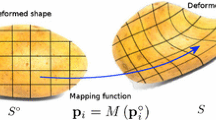Abstract
Projective distortion of surface texture observed in a perspective image can provide direct information about the shape of the underlying surface. Previous theories have generally concerned planar surfaces; this paper presents a systematic analysis of first- and second-order texture distortion cues for the case of a smooth, curved surface. In particular, several kinds of texture gradients are analyzed and are related to surface orientation and surface curvature. The local estimates obtained from these cues can be integrated to obtain a global surface shape, and it is shown that the two surfaces resulting from the well-known tilt ambiguity in the local foreshortening cue typically have qualitatively different shapes. As an example of a practical application of the analysis, a shape-from-texture algorithm based on local orientation-selective filtering is described, and some experimental results are shown.
Similar content being viewed by others
References
J. Gibson, The Perception of the Visual World, Houghton Mifflin: Boston, 1950.
J. Aloimonos, “Shape from texture”, Biol. Cybernet., vol. 58, pp. 345–360, 1988.
R. Bajcsy and L. Lieberman, “Texture gradients as a depth cue”, Comput. Graph. Image Process., vol. 5, pp. 52–67, 1976.
A. Blake and C. Marions, “Shape from texture: the homogeneity hypothesis”, in Proc. IEEE 3rd Int. Conf. on Computer Vision, Osaka, Japan, IEEE Computer Society Press, pp. 350–353, 1990.
D. Blostein and N. Ahuja, “Shape from texture: integrating texture element extraction and surface estimation”, IEEE Trans. Patt. Anal. Mach. Intell., vol. 11, pp. 1233–1251, 1989.
J. Gårding, “Shape from texture and contour by weak isotropy”, J. Artificial Intell., in press.
K. Kanatani and T.C. Chou, “Shape from texture: general principle”, J. Artificial Intell., vol. 38, pp. 1–48, 1989.
A.P. Pentland, “Shading into texture”, J. Artificial Intell., vol. 29, pp. 147–170, 1986.
A.P. Witkin, “Recovering surface shape and orientation from texture”, J. Artificial Intell., vol. 17, pp. 17–45, 1981.
D. Buckley, J.P. Frisby, and E. Spivey, “Stereo and texture cue combination in ground planes: an investigation using the table stereometer”, Perception, vol. 20, pp. 91, 1991.
J.E. Cutting and R.T. Millard, “Three gradients and the perception of flat and curved surfaces”, J. Exp. Psychol. [Gen.], vol. 113, pp. 198–216, 1984.
J.T. Todd and R.A. Akerstrom, “Perception of threedimensional form from patterns of optical texture”, J. Psychol. [Human Percept.], vol. 13, pp. 242–255, 1987.
J. Gibson, The Ecological Approach to Visual Perception, Houghton Mifflin: Boston, 1979.
J.J. Koenderink, Solid Shape, MIT Press: Cambridge, MA, 1990.
B. O'Neill, Elementary Differential Geometry, Academic Press: Orlando, FL, 1966.
K.A. Stevens, “The information content of texture gradients”, Biol. Cybernet., vol. 42, pp. 95–105, 1981.
J. Gårding, “Shape from surface markings”, Ph.D. thesis, Department of Numerical Analysis and Computing Science, Royal Institute of Technology, Stockholm, 1991.
A.C. Bovik, M. Clark, and W.S. Geisler, “Multichannel texture analysis using localized spatial filters”, IEEE Trans. Patt. Anal. Mach. Intell., vol. 12, pp. 55–73, 1990.
M.R. Turner, “Texture discrimination by Gabor function”, Biol. Cybernet., vol. 55, pp. 71–82, 1986.
J. Jones and L. Palmer, “An evaluation of the twodimensional Gabor filter model of simple receptive fields in cat striate cortex”, J. Neurophysiol., vol. 58, pp. 1233–1258, 1987.
P. Kube, “Using frequency-and orientation-tuned channels to determine surface slant”, in Proc. 8th Ann. Conf. of the Cognitive Science Society, Amherst, MA, 1986, pp. 235–244, Lawrence Erlbaum Associates.
M.R. Turner, G.L. Gerstein, and R. Bajcsy, “Underestimation of visual texture slant by human observers: a model”, Biol. Cybernet., vol. 65, pp. 215–226, 1991.
L.G. Brown and H. Shvaytser, “Surface orientation from projective foreshortening of isotropic texture autocorrelation”, IEEE Trans. Patt. Anal. Mach. Intell., vol. 12, pp. 584–588, 1990.
Author information
Authors and Affiliations
Rights and permissions
About this article
Cite this article
Gårding, J. Shape from texture for smooth curved surfaces in perspective projection. J Math Imaging Vis 2, 327–350 (1992). https://doi.org/10.1007/BF00121877
Issue Date:
DOI: https://doi.org/10.1007/BF00121877



